Sea Breeze-Driven Variations in Planetary Boundary Layer Height over Barrow: Insights from Meteorological and Lidar Observations
Abstract
1. Introduction
2. Study Area and Data
2.1. Study Area
2.2. Micropulse Lidar Data
2.3. Radiosonde Data
2.4. Other Data
3. Methodology
3.1. Retrieval Methods of PBLH
3.2. Theoretical Basis of Variable Importance in Projection Calculation
4. Results
4.1. Statistical Analysis
4.2. Meteorological Factors Under Sea Breeze and Non-Sea-Breeze Conditions
4.3. The Influence of Seabreeze on PBLH
5. Conclusions
Author Contributions
Funding
Data Availability Statement
Conflicts of Interest
References
- Seidel, D.J.; Ao, C.O.; Li, K. Estimating climatological planetary boundary layer heights from radiosonde observations: Comparison of methods and uncertainty analysis. J. Geophys. Res. Atmos. 2010, 115, D16. [Google Scholar] [CrossRef]
- Stull, R.B. An Introduction to Boundary Layer Meteorology; Springer Science & Business Media: Berlin/Heidelberg, Germany, 1988; Volume 13. [Google Scholar]
- LeMone, M.A. Boundary Layer (Atmospheric) and Air Pollution|Convective Boundary Layer. In Encyclopedia of Atmospheric Sciences, 2nd ed.; North, G.R., Pyle, J., Zhang, F., Eds.; Academic Press: Oxford, UK, 2015; pp. 250–257. [Google Scholar]
- Seidel, D.J.; Zhang, Y.; Beljaars, A.; Golaz, J.C.; Jacobson, A.R.; Medeiros, B. Climatology of the planetary boundary layer over the continental United States and Europe. J. Geophys. Res. Atmos. 2012, 117, D17. [Google Scholar] [CrossRef]
- Guo, J.; Miao, Y.; Zhang, Y.; Liu, H.; Li, Z.; Zhang, W.; He, J.; Lou, M.; Yan, Y.; Bian, L. The climatology of planetary boundary layer height in China derived from radiosonde and reanalysis data. Atmos. Chem. Phys. 2016, 16, 13309–13319. [Google Scholar] [CrossRef]
- Holtslag, A.A.; Nieuwstadt, F.T. Scsaling the atmospheric boundary layer. Bound. Layer Meteorol. 1986, 36, 201–209. [Google Scholar] [CrossRef]
- Garratt, J.R.; Hess, G.D. Boundary Layers|Neutrally Stratified Boundary Layer. In Encyclopedia of Atmospheric Sciences; Holton, J.R., Ed.; Academic Press: Oxford, UK, 2003; pp. 262–271. [Google Scholar] [CrossRef]
- Xi, X.; Yang, Q.; Liu, C.; Shupe, M.D.; Han, B.; Peng, S.; Zhou, S.; Chen, D. Evaluation of the planetary boundary layer height from ERA5 reanalysis with MOSAiC observations over the Arctic Ocean. J. Geophys. Res. Atmos. 2024, 129, e2024JD040779. [Google Scholar] [CrossRef]
- Peng, S.; Yang, Q.; Shupe, M.D.; Xi, X.; Han, B.; Chen, D.; Dahlke, S.; Liu, C. The characteristics of atmospheric boundary layer height over the Arctic Ocean during MOSAiC. Atmos. Chem. Phys. 2023, 23, 8683–8703. [Google Scholar] [CrossRef]
- Heinemann, G. The polar regions: A natural laboratory for boundary layer meteorology—A review. Meteorol. Z. 2008, 17, 589. [Google Scholar] [CrossRef]
- Dai, C.-Y.; Gao, Z.-Q.; Wang, Q.; Cheng, G. Analysis of atmospheric boundary layer height characteristics over the Arctic Ocean using the aircraft and GPS soundings. Atmos. Ocean. Sci. Lett. 2011, 4, 124–130. [Google Scholar]
- Akansu, E.F.; Dahlke, S.; Siebert, H.; Wendisch, M. Evaluation of methods to determine the surface mixing layer height of the atmospheric boundary layer in the central Arctic during polar night and transition to polar day in cloudless and cloudy conditions. Atmos. Chem. Phys. 2023, 23, 15473–15489. [Google Scholar] [CrossRef]
- Li, H.; Liu, B.; Gong, W.; Ma, Y.; Jin, S.; Wang, W.; Fan, R.; Jiang, S. Influence of clouds on planetary boundary layer height: A comparative study and factors analysis. Atmos. Res. 2025, 314, 107784. [Google Scholar] [CrossRef]
- Anthes, R.A. The height of the planetary boundary layer and the production of circulation in a sea breeze model. J. Atmos. Sci. 1978, 35, 1231–1239. [Google Scholar] [CrossRef]
- Miller, S.; Keim, B.; Talbot, R.; Mao, H. Sea breeze: Structure, forecasting, and impacts. Rev. Geophys. 2003, 41, 1011. [Google Scholar] [CrossRef]
- De Tomasi, F.; Miglietta, M.M.; Perrone, M.R. The growth of the planetary boundary layer at a coastal site: A case study. Bound. Layer Meteorol. 2011, 139, 521–541. [Google Scholar] [CrossRef]
- Abbs, D.J.; Physick, W.L. Sea-breeze observations and modelling—A review. Aust. Meteorol. Mag. 1992, 41, 7–19. [Google Scholar]
- Challa, V.S.; Indracanti, J.; Rabarison, M.K.; Patrick, C.; Baham, J.M.; Young, J.; Hughes, R.; Hardy, M.G.; Swanier, S.J.; Yerramilli, A. A simulation study of mesoscale coastal circulations in Mississippi Gulf coast. Atmos. Res. 2009, 91, 9–25. [Google Scholar] [CrossRef]
- Papanastasiou, D.; Melas, D. Climatology and impact on air quality of sea breeze in an urban coastal environment. Int. J. Climatol. J. R. Meteorol. Soc. 2009, 29, 305–315. [Google Scholar] [CrossRef]
- Caicedo, V.; Rappenglueck, B.; Cuchiara, G.; Flynn, J.; Ferrare, R.; Scarino, A.; Berkoff, T.; Senff, C.; Langford, A.; Lefer, B. Bay breeze and sea breeze circulation impacts on the planetary boundary layer and air quality from an observed and modeled DISCOVER-AQ Texas case study. J. Geophys. Res. Atmos. 2019, 124, 7359–7378. [Google Scholar] [CrossRef]
- Igel, A.L.; van den Heever, S.C.; Johnson, J.S. Meteorological and land surface properties impacting sea breeze extent and aerosol distribution in a dry environment. J. Geophys. Res. Atmos. 2018, 123, 22–37. [Google Scholar] [CrossRef]
- He, J.; Kang, Y.; Wang, Y.; Gu, Y.; Zhong, K. Effects of sea-land breeze on air pollutant dispersion in street networks with different distances from coast using WRF-CFD coupling method. Sustain. Cities Soc. 2024, 115, 105757. [Google Scholar] [CrossRef]
- Davis, S.R.; Farrar, J.T.; Weller, R.A.; Jiang, H.; Pratt, L.J. The land-sea breeze of the red sea: Observations, simulations, and relationships to regional moisture transport. J. Geophys. Res. Atmos. 2019, 124, 13803–13825. [Google Scholar] [CrossRef]
- Aliabadi, A.; Staebler, R.; De Grandpré, J.; Zadra, A.; Vaillancourt, P. Comparison of estimated atmospheric boundary layer mixing height in the Arctic and southern Great Plains under statically stable conditions: Experimental and numerical aspects. Atmos. Ocean 2016, 54, 60–74. [Google Scholar] [CrossRef]
- Davis, E.V.; Rajeev, K.; Mishra, M.K. Effect of clouds on the diurnal evolution of the atmospheric boundary-layer height over a tropical coastal station. Bound. Layer Meteorol. 2020, 175, 135–152. [Google Scholar] [CrossRef]
- Liu, H.; Chan, J.C.; Cheng, A.Y. Internal boundary layer structure under sea-breeze conditions in Hong Kong. Atmos. Environ. 2001, 35, 683–692. [Google Scholar] [CrossRef]
- Pal, S.; Clark, N.E.; Lee, T.R.; Conder, M.; Buban, M. When and where horizontal advection is critical to alter atmospheric boundary layer dynamics over land: The need for a conceptual framework. Atmos. Res. 2021, 264, 105825. [Google Scholar] [CrossRef]
- Reddy, T.R.; Mehta, S.K.; Ananthavel, A.; Ali, S.; Annamalai, V.; Rao, D.N. Seasonal characteristics of sea breeze and thermal internal boundary layer over Indian east coast region. Meteorol. Atmos. Phys. 2021, 133, 217–232. [Google Scholar] [CrossRef]
- Pal, S.; Lee, T.R. Contrasting air mass advection explains significant differences in boundary layer depth seasonal cycles under onshore versus offshore flows. Geophys. Res. Lett. 2019, 46, 2846–2853. [Google Scholar] [CrossRef]
- Verlinde, J.; Zak, B.; Shupe, M.; Ivey, M.; Stamnes, K. The arm north slope of alaska (nsa) sites. Meteorol. Monogr. 2016, 57, 8.1–8.13. [Google Scholar] [CrossRef]
- Spangenberg, D.; Chakrapani, V.; Doelling, D.; Minnis, P.; Arduini, R. Development of an automated Arctic cloud mask using clear-sky satellite observations taken over the SHEBA and ARM NSA sites. In Proceedings of the 6th Conference on Polar Meteorology and Oceanography, San Diego, CA, USA, 14–18 May 2001; pp. 14–18. [Google Scholar]
- Qiu, S.; Dong, X.; Xi, B.; Li, J.L. Characterizing Arctic mixed-phase cloud structure and its relationship with humidity and temperature inversion using ARM NSA observations. J. Geophys. Res. Atmos. 2015, 120, 7737–7746. [Google Scholar] [CrossRef]
- Doty, K.J. Metadata Systems for Arms SGP and NSA Sites; Brookhaven National Lab. (BNL): Upton, NY, USA, 1999. [Google Scholar]
- Muradyan, P.; Coulter, R. Micropulse Lidar (MPL) Instrument Handbook. DOE/SC-ARM-TR-019, 20 pp. 2020. Available online: https://www.arm.gov/publications/tech_reports/handbooks/mpl_handbook.pdf (accessed on 4 May 2025).
- Campbell, J.R.; Hlavka, D.L.; Welton, E.J.; Flynn, C.J.; Turner, D.D.; Spinhirne, J.D.; Scott III, V.S.; Hwang, I. Full-time, eye-safe cloud and aerosol lidar observation at atmospheric radiation measurement program sites: Instruments and data processing. J. Atmos. Ocean. Technol. 2002, 19, 431–442. [Google Scholar] [CrossRef]
- Li, H.; Liu, B.; Ma, X.; Jin, S.; Wang, W.; Fan, R.; Ma, Y.; Wei, R.; Gong, W. Estimation of Planetary Boundary Layer Height from Lidar by Combining Gradient Method and Machine Learning Algorithms. IEEE Trans. Geosci. Remote Sens. 2023, 61, 1–11. [Google Scholar] [CrossRef]
- Campbell, J.R.; Welton, E.J.; Spinhirne, J.D.; Ji, Q.; Tsay, S.C.; Piketh, S.J.; Barenbrug, M.; Holben, B.N. Micropulse lidar observations of tropospheric aerosols over northeastern South Africa during the ARREX and SAFARI 2000 dry season experiments. J. Geophys. Res. Atmos. 2003, 108, D13. [Google Scholar] [CrossRef]
- Han, G.; Huang, Y.; Shi, T.; Zhang, H.; Li, S.; Zhang, H.; Chen, W.; Liu, J.; Gong, W. Quantifying CO2 emissions of power plants with Aerosols and Carbon Dioxide Lidar onboard DQ-1. Remote Sens. Environ. 2024, 313, 114368. [Google Scholar] [CrossRef]
- Wang, W.; Li, B.; Chen, B. Improved surface NO2 Retrieval: Double-layer machine learning model construction and spatio-temporal characterization analysis in China (2018–2023). J. Environ. Manage. 2025, 384, 125439. [Google Scholar] [CrossRef]
- Heffter, J. Transport layer depth calculations. Presented at the Second Joint Conference on Applications of Air Pollution Meteorology, New Orleans, LA, USA, 24–27 March 1980; American Meteorological Society: Boston, MA, USA, 1980; Volume 24, p. 28. [Google Scholar]
- Richardson, H.; Basu, S.; Holtslag, A. Improving stable boundary-layer height estimation using a stability-dependent critical bulk Richardson number. Bound. Layer Meteorol. 2013, 148, 93–109. [Google Scholar] [CrossRef]
- Liu, S.; Liang, X.-Z. Observed diurnal cycle climatology of planetary boundary layer height. J. Clim. 2010, 23, 5790–5809. [Google Scholar] [CrossRef]
- Xie, S.; McCoy, R.B.; Klein, S.A.; Cederwall, R.T.; Wiscombe, W.J.; Clothiaux, E.E.; Gaustad, K.L.; Golaz, J.-C.; Hall, S.D.; Jensen, M.P. ARM climate modeling best estimate data: A new data product for climate studies. Bull. Am. Meteorol. Soc. 2010, 91, 13–21. [Google Scholar] [CrossRef]
- Yang, J.; Gan, R.; Luo, B.; Wang, A.; Shi, S.; Du, L. An improved method for individual tree segmentation in complex urban scene based on using multispectral LiDAR by deep learning. IEEE J. Sel. Top. Appl. Earth Obs. Remote Sens. 2024, 17, 6561–6576. [Google Scholar] [CrossRef]
- Li, H.; Chang, J.; Liu, Z.; Zhang, L.; Dai, T.; Chen, S. An improved method for automatic determination of the planetary boundary layer height based on lidar data. J. Quant. Spectrosc. Radiat. Transf. 2020, 257, 107382. [Google Scholar] [CrossRef]
- Breiman, L. Random forests. Mach. Learn. 2001, 45, 5–32. [Google Scholar] [CrossRef]
- Zhang, D.; Comstock, J.; Morris, V. Comparison of planetary boundary layer height from ceilometer with ARM radiosonde data. Atmos. Meas. Tech. 2022, 15, 4735–4749. [Google Scholar] [CrossRef]
- Zheng, R.; Chen, Z.; Guan, Z.; Zhao, C.; Cui, H.; Shang, H. Variable importance for projection (VIP) scores for analyzing the contribution of risk factors in severe adverse events to Xiyanping injection. Chin. Med. 2023, 18, 15. [Google Scholar] [CrossRef] [PubMed]
- Oussama, A.; Elabadi, F.; Platikanov, S.; Kzaiber, F.; Tauler, R. Detection of olive oil adulteration using FT-IR spectroscopy and PLS with variable importance of projection (VIP) scores. J. Am. Oil Chem. Soc. 2012, 89, 1807–1812. [Google Scholar] [CrossRef]
- Farrés, M.; Platikanov, S.; Tsakovski, S.; Tauler, R. Comparison of the variable importance in projection (VIP) and of the selectivity ratio (SR) methods for variable selection and interpretation. J. Chemom. 2015, 29, 528–536. [Google Scholar] [CrossRef]
- Mahieu, B.; Qannari, E.M.; Jaillais, B. Extension and significance testing of Variable Importance in Projection (VIP) indices in Partial Least Squares regression and Principal Components Analysis. Chemom. Intell. Lab. Syst. 2023, 242, 104986. [Google Scholar] [CrossRef]
- Joshi, M.M.; Gregory, J.M.; Webb, M.J.; Sexton, D.M.; Johns, T.C. Mechanisms for the land/sea warming contrast exhibited by simulations of climate change. Clim. Dyn. 2008, 30, 455–465. [Google Scholar] [CrossRef]
- Liu, B.; Ma, X.; Ma, Y.; Li, H.; Jin, S.; Fan, R.; Gong, W. The relationship between atmospheric boundary layer and temperature inversion layer and their aerosol capture capabilities. Atmos. Res. 2022, 271, 106121. [Google Scholar] [CrossRef]
- Oksman, J. Proposed annual and sunspot cycle variation of the plasmasphere of the Earth. Nat. Phys. Sci. 1971, 231, 12–13. [Google Scholar] [CrossRef]
- Faizal, M.; Rafiuddin Ahmed, M. On the ocean heat budget and ocean thermal energy conversion. Int. J. Energy Res. 2011, 35, 1119–1144. [Google Scholar] [CrossRef]
- Gu, W.; Zhu, L.Y.; Cui, W.J.; Li, N.; Cong, J.O.; Xu, Y.J.; Huang, S.Q.; Yu, H.Y.; Li, L.T. The research of sea-land breeze (SLB) on the west coast of Bohai Bay based on field observation. Ences Cold Arid Reg. 2011, 3, 264–273. [Google Scholar]
- Zhang, L.; Xin, J.; Yin, Y.; Wang, Z.; Wang, D.; Ma, Y.; Jia, D.; Jiang, Y.; Wu, L.; Pan, X. Adaptability evaluation of boundary layer schemes for simulation of sea and land breeze circulation in the west coast of the Yellow Sea. Atmos. Res. 2022, 278, 106354. [Google Scholar] [CrossRef]
- Wild, M. Decadal changes in radiative fluxes at land and ocean surfaces and their relevance for global warming. Wiley Interdiscip. Rev. Clim. Change 2016, 7, 91–107. [Google Scholar] [CrossRef]
- Cheung, T.K. Sodar observations of the stable lower atmospheric boundary layer at Barrow, Alaska. Bound. Layer Meteorol. 1991, 57, 251–274. [Google Scholar] [CrossRef]
- Lee, Y.-H.; Park, M.-S.; Choi, Y. Planetary boundary-layer structure at an inland urban site under sea breeze penetration. Asia-Pac. J. Atmos. Sci. 2021, 57, 701–715. [Google Scholar] [CrossRef]
- Liu, B.; Ma, Y.; Gong, W.; Zhang, M.; Yang, J. Determination of boundary layer top on the basis of the characteristics of atmospheric particles. Atmos. Environ. 2018, 178, 140–147. [Google Scholar] [CrossRef]
- Rahman, K.; Rios, G.; Gamarro, H.; Addasi, O.; Peña, J.C.; Gonzalez-Cruz, J.; Bornstein, R.; Ramamurthy, P. The boundary layer characteristics of coastal urban environments. Theor. Appl. Climatol. 2024, 155, 6931–6948. [Google Scholar] [CrossRef]
- Simpson, J.; Mansfield, D.; Milford, J. Inland penetration of sea-breeze fronts. Q. J. R. Meteorol. Soc. 1977, 103, 47–76. [Google Scholar]
- Pithan, F.; Svensson, G.; Caballero, R.; Chechin, D.; Cronin, T.W.; Ekman, A.M.; Neggers, R.; Shupe, M.D.; Solomon, A.; Tjernström, M. Role of air-mass transformations in exchange between the Arctic and mid-latitudes. Nat. Geosci. 2018, 11, 805–812. [Google Scholar] [CrossRef]
- Ju, T.; Wu, B.; Zhang, H.; Wang, Z.; Liu, J. Impacts of boundary-layer structure and turbulence on the variations of PM2.5 during fog–haze episodes. Bound. Layer Meteorol. 2022, 183, 469–493. [Google Scholar] [CrossRef]
- Stapf, J.; Ehrlich, A.; Jäkel, E.; Lüpkes, C.; Wendisch, M. Reassessment of shortwave surface cloud radiative forcing in the Arctic: Consideration of surface-albedo–cloud interactions. Atmos. Chem. Phys. 2020, 20, 9895–9914. [Google Scholar] [CrossRef]
- Xu, H.; Guo, J.; Li, J.; Liu, L.; Chen, T.; Guo, X.; Lyu, Y.; Wang, D.; Han, Y.; Chen, Q. The significant role of radiosonde-measured cloud-base height in the estimation of cloud radiative forcing. Adv. Atmos. Sci. 2021, 38, 1552–1565. [Google Scholar] [CrossRef]
- Allabakash, S.; Lim, S. Climatology of planetary boundary layer height-controlling meteorological parameters over the Korean Peninsula. Remote Sens. 2020, 12, 2571. [Google Scholar] [CrossRef]
- Darand, M.; Zandkarimi, F. Identification of atmospheric boundary layer height and trends over Iran using high-resolution ECMWF reanalysis dataset. Theor. Appl. Climatol. 2019, 137, 1457–1465. [Google Scholar] [CrossRef]
- Miao, Y.; Guo, J.; Liu, S.; Liu, H.; Li, Z.; Zhang, W.; Zhai, P. Classification of summertime synoptic patterns in Beijing and their associations with boundary layer structure affecting aerosol pollution. Atmos. Chem. Phys. 2017, 17, 3097–3110. [Google Scholar] [CrossRef]
- Mengis, N.; Martin, T.; Keller, D.P.; Oschlies, A. Assessing climate impacts and risks of ocean albedo modification in the Arctic. J. Geophys. Res. Ocean. 2016, 121, 3044–3057. [Google Scholar] [CrossRef]
- Shupe, M.D.; Intrieri, J.M. Cloud radiative forcing of the Arctic surface: The influence of cloud properties, surface albedo, and solar zenith angle. J. Clim. 2004, 17, 616–628. [Google Scholar] [CrossRef]
- Schneider, T.; O’Gorman, P.A.; Levine, X.J. Water vapor and the dynamics of climate changes. Rev. Geophys. 2010, 48, RG3001. [Google Scholar] [CrossRef]
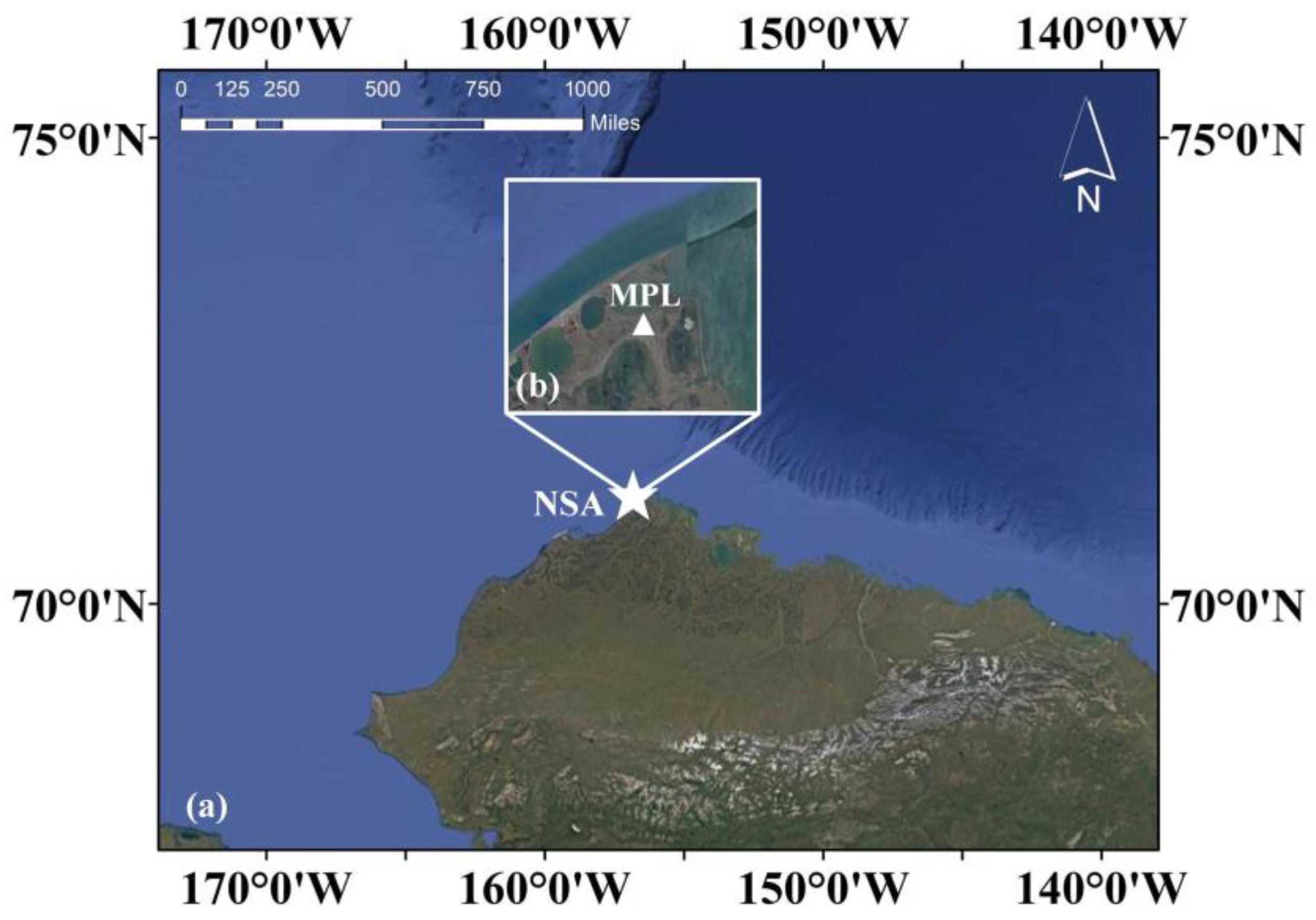
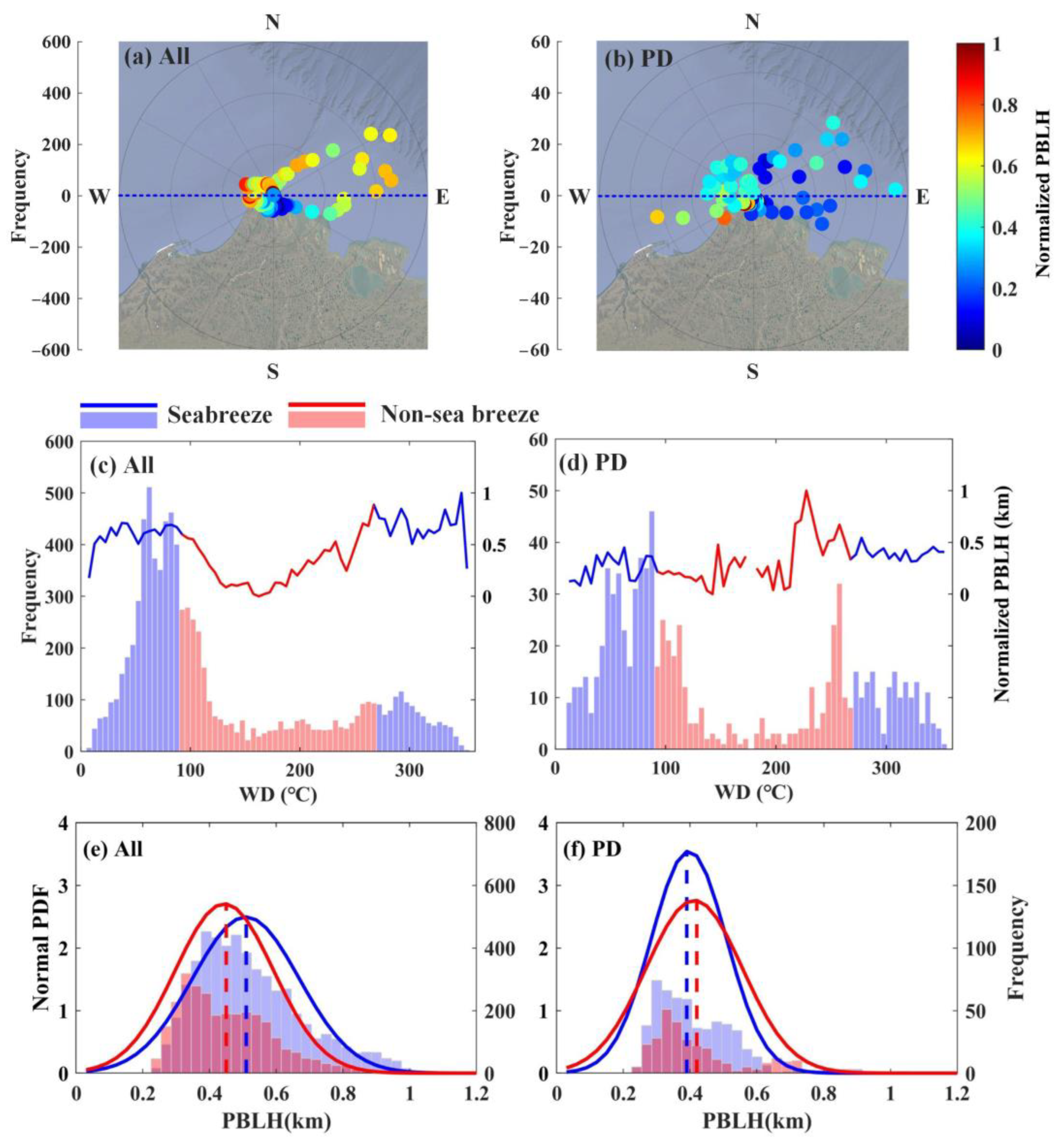
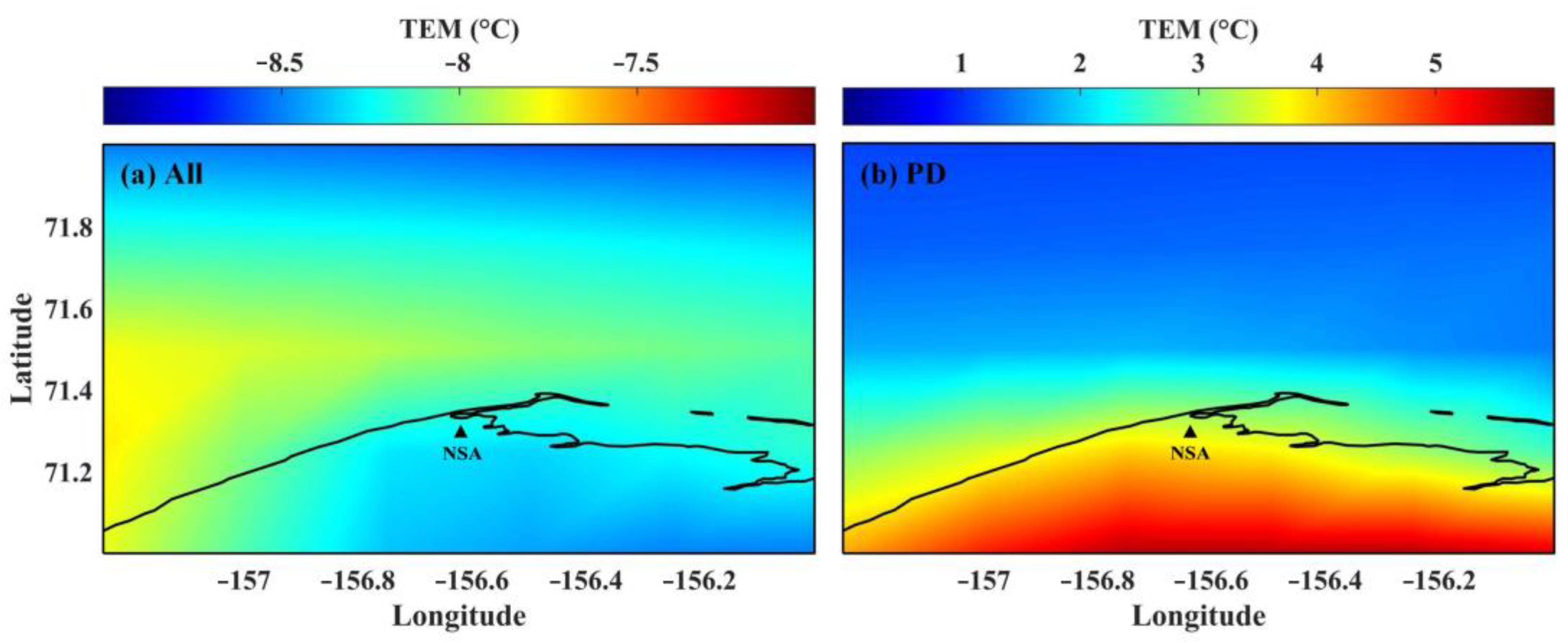
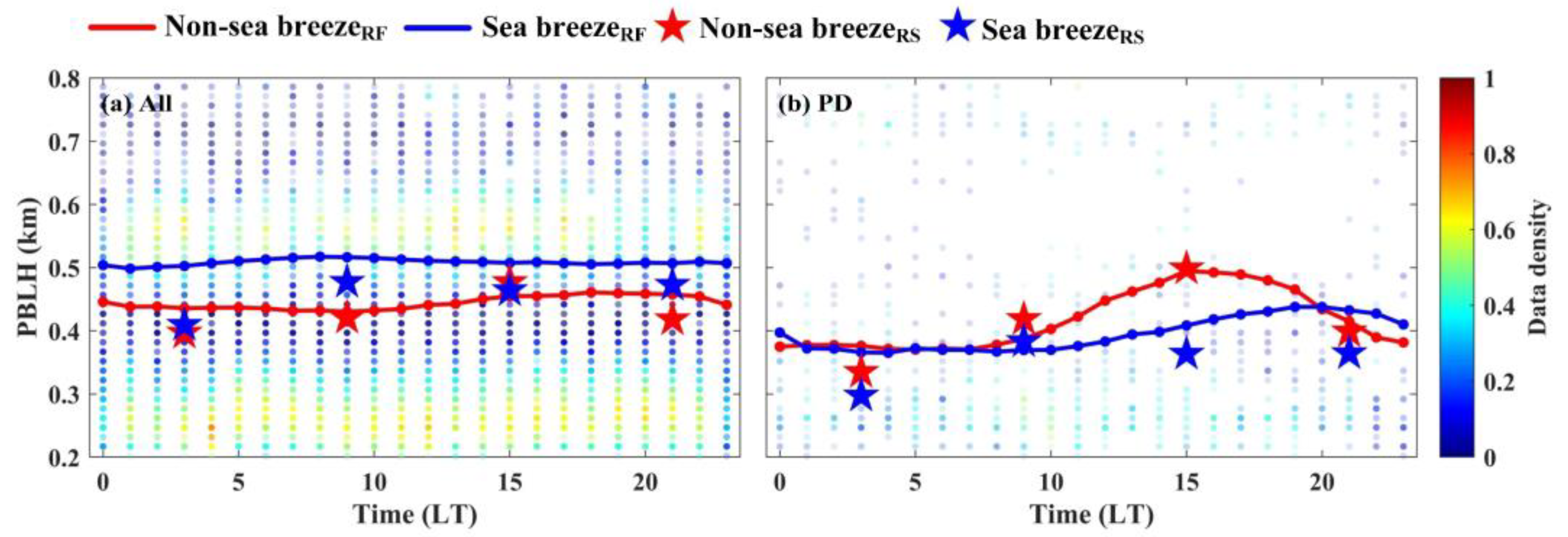
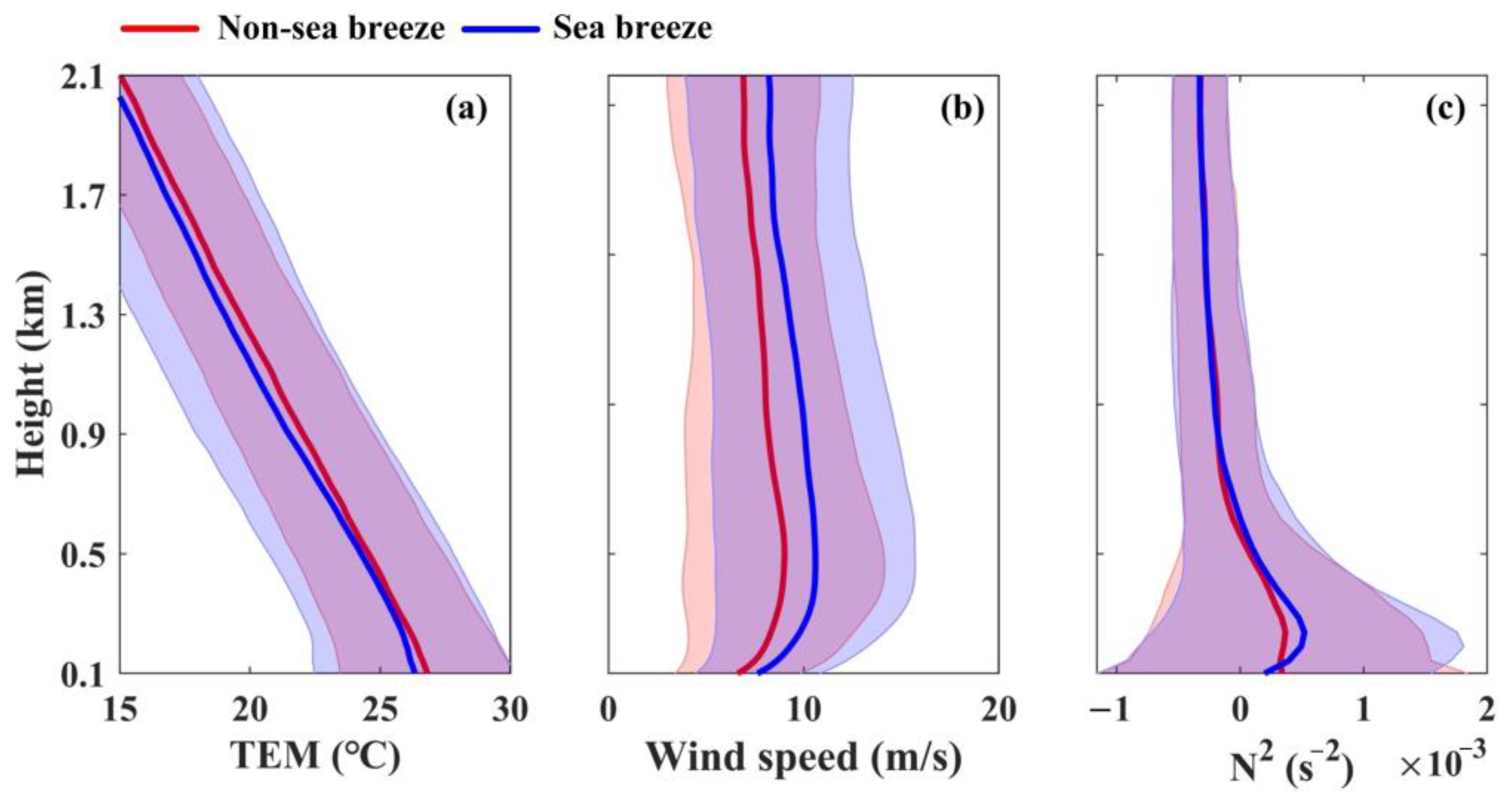
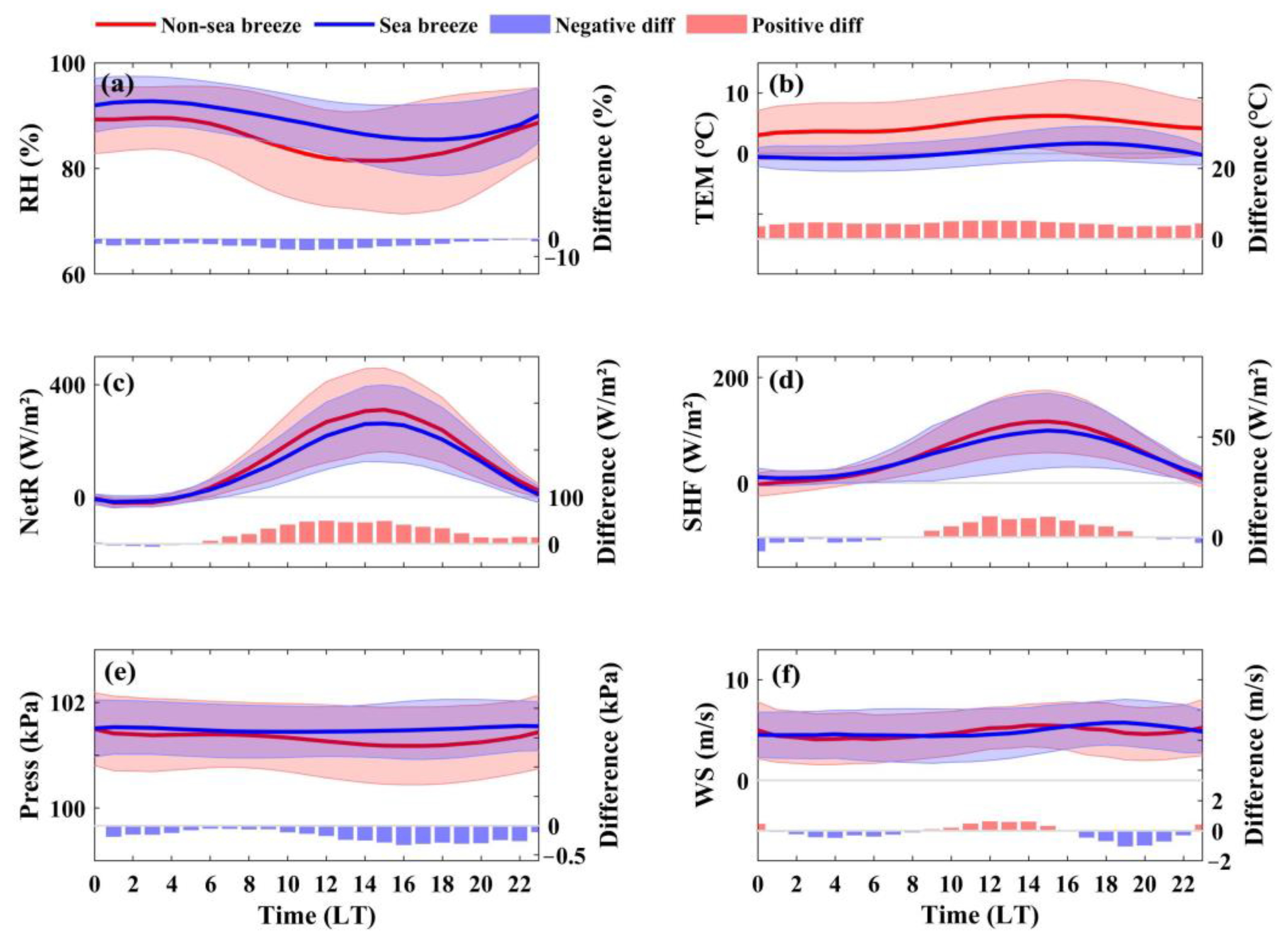

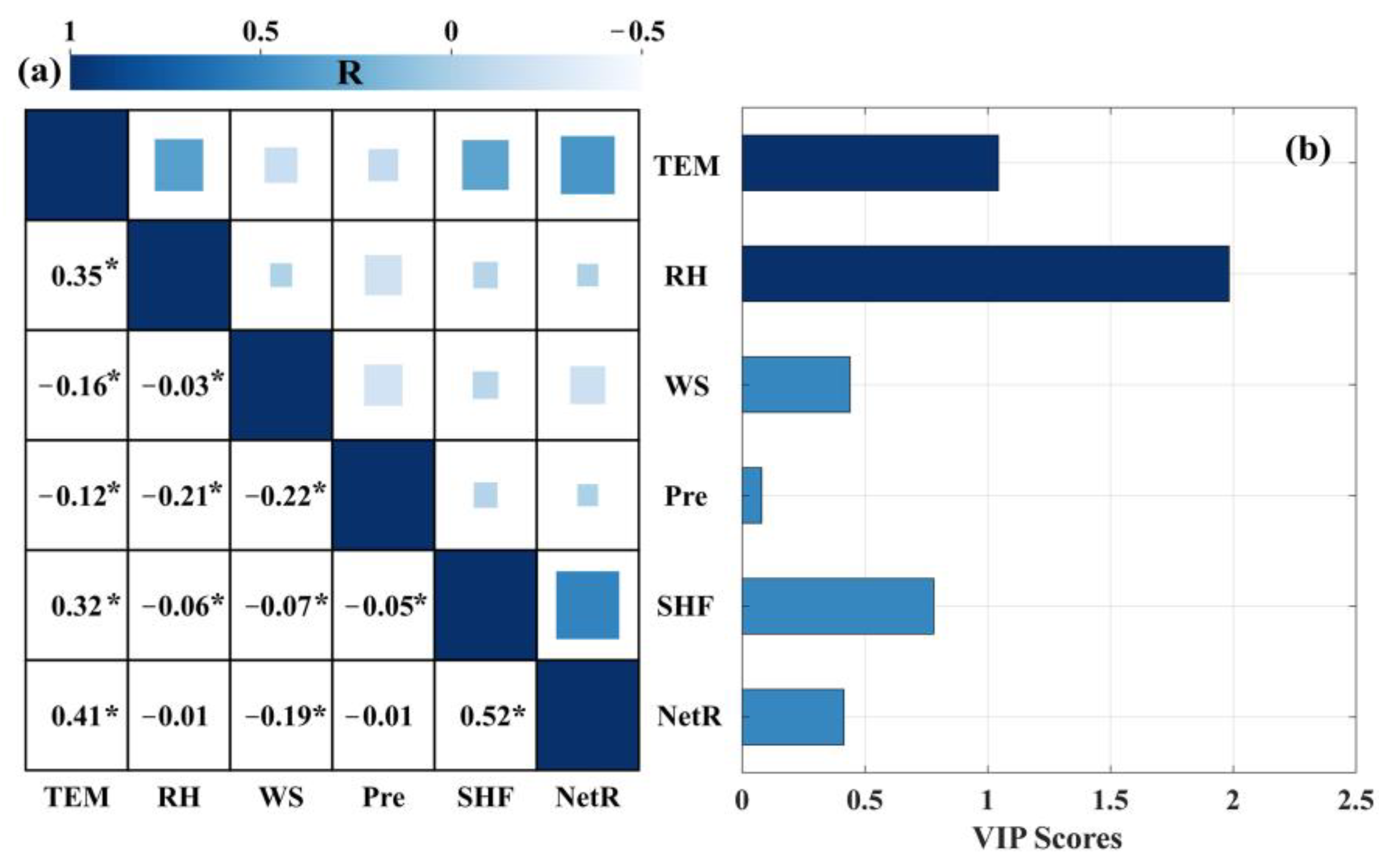

Disclaimer/Publisher’s Note: The statements, opinions and data contained in all publications are solely those of the individual author(s) and contributor(s) and not of MDPI and/or the editor(s). MDPI and/or the editor(s) disclaim responsibility for any injury to people or property resulting from any ideas, methods, instructions or products referred to in the content. |
© 2025 by the authors. Licensee MDPI, Basel, Switzerland. This article is an open access article distributed under the terms and conditions of the Creative Commons Attribution (CC BY) license (https://creativecommons.org/licenses/by/4.0/).
Share and Cite
Li, H.; Gong, W.; Liu, B.; Ma, Y.; Jin, S.; Wang, W.; Fan, R.; Jiang, S.; Wang, Y.; Tong, Z. Sea Breeze-Driven Variations in Planetary Boundary Layer Height over Barrow: Insights from Meteorological and Lidar Observations. Remote Sens. 2025, 17, 1633. https://doi.org/10.3390/rs17091633
Li H, Gong W, Liu B, Ma Y, Jin S, Wang W, Fan R, Jiang S, Wang Y, Tong Z. Sea Breeze-Driven Variations in Planetary Boundary Layer Height over Barrow: Insights from Meteorological and Lidar Observations. Remote Sensing. 2025; 17(9):1633. https://doi.org/10.3390/rs17091633
Chicago/Turabian StyleLi, Hui, Wei Gong, Boming Liu, Yingying Ma, Shikuan Jin, Weiyan Wang, Ruonan Fan, Shuailong Jiang, Yujie Wang, and Zhe Tong. 2025. "Sea Breeze-Driven Variations in Planetary Boundary Layer Height over Barrow: Insights from Meteorological and Lidar Observations" Remote Sensing 17, no. 9: 1633. https://doi.org/10.3390/rs17091633
APA StyleLi, H., Gong, W., Liu, B., Ma, Y., Jin, S., Wang, W., Fan, R., Jiang, S., Wang, Y., & Tong, Z. (2025). Sea Breeze-Driven Variations in Planetary Boundary Layer Height over Barrow: Insights from Meteorological and Lidar Observations. Remote Sensing, 17(9), 1633. https://doi.org/10.3390/rs17091633









